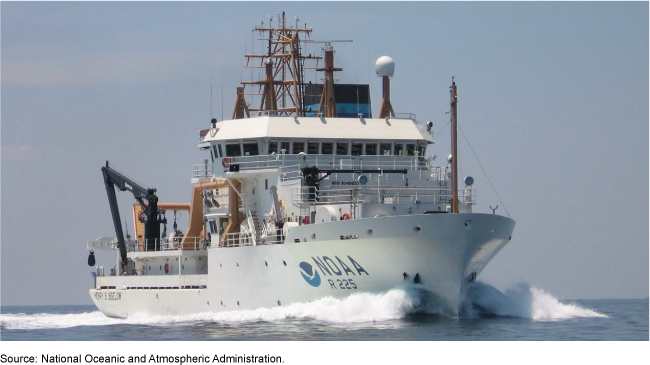NOAA Mariner Recruitment and Retention: Actions Needed to Develop a Strategic Workforce Planning Process
Fast Facts
The National Oceanic and Atmospheric Administration has 15 ships it uses for fisheries research, nautical charting, and other scientific missions. NOAA needs more mariners to support these ships. This Q&A report examines NOAA's recruitment and retention efforts amid a global mariner shortage.
For example, a recent effort to address mariner feedback aims to reduce the stretches of time that NOAA mariners spend at sea. NOAA has also given recruitment and retention bonuses to mariners.
But having workforce plans would put NOAA in a better position to recruit and retain mariners. We recommended developing a workforce planning process.

Highlights
What GAO Found
The National Oceanic and Atmospheric Administration's (NOAA) marine operations mission is to support its environmental science and stewardship goals through the operation, maintenance, and modernization of its ships. NOAA's Office of Marine and Aviation Operations (OMAO) plays a central role in enabling NOAA to conduct research, collect data, and carry out various mandates related to oceanography, atmospheric science, climate research, and more. According to OMAO officials, they need to increase the number of NOAA Commissioned Officer Corps (NOAA Corps) officers and civilian professional mariners (professional mariners) to meet NOAA's marine operations mission requirements. NOAA data show that recruitment and retention varied for the NOAA Corps and professional mariners over the last 5 fiscal years, with separations outpacing hiring in some of those years.
Factors that affect NOAA mariner recruitment and retention include challenges with work-life balance and pay, among others. OMAO has taken a variety of actions to address recruitment and retention challenges. However, OMAO does not have active workforce plans for the NOAA Corps or professional mariners to guide its efforts to improve mariner recruitment and retention and to expand the size of these mariner workforces. By developing and implementing a workforce planning process, OMAO can ensure that it consistently has active workforce plans. As OMAO develops a workforce planning process, incorporating key principles for effective strategic workforce planning (see figure below) would better position OMAO to grow its mariner workforces and meet mission requirements.
Key Principles for Effective Strategic Workforce Planning

Why GAO Did This Study
NOAA mariners—which include the NOAA Corps officers as well as professional mariners—operate the nation's largest fleet of federal research and survey ships. This fleet of 15 ships, managed by OMAO, operates worldwide to conduct scientific missions such as nautical charting, fisheries research and surveys, and atmospheric research. The James M. Inhofe National Defense Authorization Act for Fiscal Year 2023 includes a provision for GAO to review issues related to the recruitment and retention of NOAA mariners.
This report provides information on the status of recruitment and retention of NOAA mariners, OMAO efforts to address factors that affect mariner recruitment and retention, the extent to which OMAO has implemented strategic workforce planning for its mariner workforce, and other maritime organizations' approaches for recruiting and retaining mariners.
GAO reviewed NOAA data on mariner hiring and separations from fiscal years 2019 through 2023 and reviewed documentation of OMAO efforts to improve recruitment and retention among its mariner workforces. In addition, GAO visited two NOAA vessels to observe NOAA mariner working conditions. GAO interviewed OMAO officials, NOAA Corps officers and professional mariners, and representatives of employee groups and unions.
Recommendations
GAO is recommending that OMAO develop and implement a workforce planning process that covers both the NOAA Corps and professional mariners and incorporates key principles of effective strategic workforce planning.
Recommendations for Executive Action
| Agency Affected | Recommendation | Status |
|---|---|---|
| Office of Marine and Aviation Operations | The Director of OMAO should develop and implement a workforce planning process that covers both the NOAA Corps and professional mariners and incorporates key principles of effective strategic workforce planning. (Recommendation 1) |
The Department of Commerce (Commerce) concurred with the recommendation and, in December 2025, described planned actions to address it. According to Commerce documentation, the NOAA Office of Marine and Aviation Operations will develop and implement workforce plans for NOAA Corps Officers and civilian professional mariners. These plans, according to the documentation, will incorporate key principles for effective workforce planning and address recruitment, onboarding, operational assignments, professional development, and retention. Commerce expects the workforce plans to be completed by January 2026. We will continue to monitor Commerce's efforts to address this recommendation.
|
